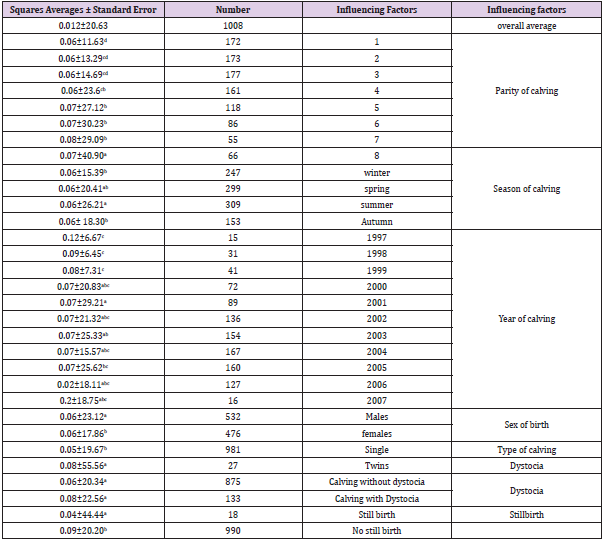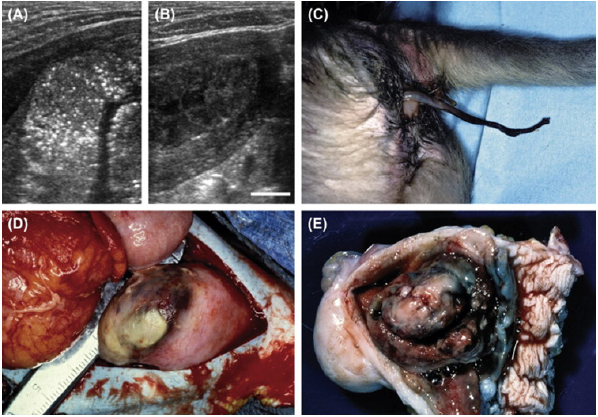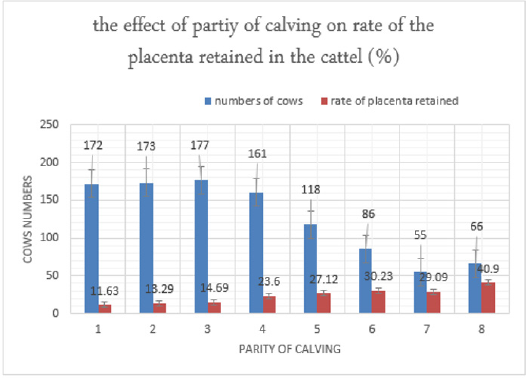Some Reproductive Problems in Friesian Cows Raised in Yemen (2- Retained Placenta)
Background
Reproductive problems have an essential effect on the productivity of dairy cows by reducing reproductive efficiency and shortening the length of productive life by increasing exclusion and reducing milk production [1]. There is a positive genetic relationship between reproductive problems in cows and the level of productivity and longevity. Thus, achieving maximum improvement Hereditary depends on the existence of an effective program to treat reproductive problems in the herd. Unlike this program, reproductive issues may lead to the loss of cows and increase the length of a generation, which leads to a decrease in the amount of genetic improvement achieved in a certain period [2]. The bovine placenta is classified as Cotyledonary Placenta and consists of Uterine Caruncles on the maternal and Fetal Cotyledons. From the side of the fetus and together, they form the placenames [3]. The primary function of the placenta is the exchange of nutrients from the mother with the excretory products of the developing fetus. In addition to that, it acts on the secretion of estrogen and several secondary steroids and their receptors [2].
The placenta or “fetal membrane” is a significant organ for nutritional and oxygen supply from the dam to the fetus in the uterine [3]. The placenta is complex hormones, and they begin to separate from the mother before birth and shortly after birth through a hormonal process. The exit of the placenta from the uterus (up to 12 hours) for any reason. This condition is called the retained placenta. Usually, part of the placenta is retained in the uterus, resulting in no estrus. In this case, the corpus luteum may be affected, and the mother will be calving stillbirth and secrete the hormone progesterone, which prevents the occurrence of estrus [2]. The causes of placental retention vary, including genetic and non-genetic. Also, among the reasons for placental retention is a lack of mineral salts, vitamin B, A, and selenium, as well as miscarriage [2,4] in addition to germs and diseases that result from these reasons, the shortage of the productive herd and the low productivity of the births and milk yield [5].
Twin births and prolonged pregnancy are also influences that cause placental retention (183 and disease problems that lead to retention of the placenta [6]. And since the future of the cattle herds depends mainly on choosing the right way to raise and raise wheels and strong-bodied cows to replace the excluded cows, this is one of the essential foundations. Because this reproductive problem represents a significant obstacle to most cattle breeding farms and due to the lack of studies in Yemen that have been subjected to placenta retention as a reproductive problem in dairy cows (Friesian) raised in Yemen, this study aimed to study placental retention in Friesian cows raised in Al-Bun farm in Amran governorate. It also aims to study the effect of some environmental factors on the occurrence of this reproductive problem.
Materials and Working Methods
Management and Reproduction
The study was carried out on a herd of Friesian cows raised in the Al-Bun farm of the Agricultural Cooperative Union located in the bottom of Al-Bun, Amran Governorate, approximately 50 km (northwest of Sana’a). The farm was established in 1993 with 40 heads of cows obtained from the Rasbbah farm in Dhamar governorate and fifty heads. (50 from the Netherlands, and the number of the herd at the time of the study was 505 cows. Estrus is monitored and detected in the barns by veterinary monitors and workers on the farm during the day and night, and estrus is monitored in the farm. In the case of the detection of estrus, the cows are naturally inseminated in the barns. The first insemination process is carried out depending on age and weight, so they are vaccinated at the age of 18 months with a weight of not less than 400 kg. If the weight is less, the vaccination process is delayed until they reach the appropriate weight. There is a health and preventive program as all farm animals are vaccinated against FMD twice a year, and the cows are examined periodically for investigation. On brucellosis and weaning vaccinations against Brucella after weaning (the feeding program was discussed in the first part of the research).
How To Deal with the Retention of the Placenta in the Farm
The appearance of retention of the placenta is more common in the case of twin deliveries and cases of miscarriage after 12 hours of birth, and in the case of delaying the descent of the placenta, a veterinary intervention is performed to remove it, so retention of the placenta is dealt with according to the following steps:
1. Removal of the placenta by specialists and veterinarians’ healthy way.
2. Putting uterine capsules into the uterus is an antibiotic.
3. Do a uterine massage to expel dirt.
4. Washing the uterus with iodine solution.
5. Injecting the cow that was exposed to the retention of the placenta with appropriate short-acting antibiotics, and the antibiotic may be re-used if signs of inflammation appear in the uterus.
Statistical Analysis
According to a mathematical model, the birth records of 1008 observations of placental retention were analyzed using the General Linear Model method. The analysis was done on the basis that the studied trait is a binary trait (yes or no) according to [7] did and [8] according to the following model.
Yijklmn = μ + Ri + Sj + Tk + Vi + Xm + Zn + Yo + Eijklmn
• Yijklmn= The studied characteristic (placental retention rate), where they gave a symbol (0) for cows that did not experience placenta retention and a sign [9] for cows that were exposed to placental retention.
• μ=the general average of the studied trait.
• Ri=effect of parity of calving [9- 12,13,6,4,8,14].
• Si=effect of the season of calving (winter, spring, summer, autumn).
• Tk=the effect of the calving year, and it contained 11 years (from 1997 to 2007).
• Vi=the effect of the type of calving (single - twin).
• Xm= the influence of sex of calving (male-female).
• Zn= the effect of Dystocia (cows with calving dystocia – cows without calving dystocia).
• Yo= effect the stillbirth (cows whose births were stillbirth - cows that not still their births).
• Eijklmno= The effect of random error, which assumes an independent normal distribution with a mean of 0 e σ2.
Results
Some of the Factors Affecting Placental Retention
The general mean ± standard error of placental retention was 20.63 ± 0.0121%. (Table 1), and that the increase in this rate on the farm reflects a defect in management. That placental retention is affected by nutritional factors [2], environmental, genetic, and physiological, and the effect of maternal births, abortions, and length of pregnancy [15].
Table 1: Continued the mean of least squares ± standard error of factors affecting placental retention in Friesian cows(%).
Parity of Calving
The results of the current study showed that the effect of the birth sequence was highly significant (P<0.01) on the Incidence of placental retention (Table 2), as it is evident from (Figure 1) that placental retention increases with successive births, as the highest rate of birth cows in the eighth sequence was 40.90%) The lowest rate of birth cows in the first sequence (11.63%). This high rate of placental retention as cow’s age is due to increased maternal births that have a short gestation period, leading to cows being exposed to placental retention [15].
Season of Calving
A significant effect (p<0.01) of the calving of the season was reported on the Incidence of placental retention, (Table 2), as the cows born in the summer season were more prone to placental retention (26.21%) compared to the cows bred in the winter season (15.39%). The seasonal variation is due to the difference in the degree of heat, humidity and its implications for the quantity and quality of feeds [16], as placental retention is affected by dietary factors such as a lack of mineral salts, vitamins E and B, selenium, and a deficiency of vitamin E in the feed (food), which is included in the composition of the epithelial layer of the placenta, which prevents Attachment of the placenta to the wall of the uterus during calving and prevention of retention [16].
Year of Calving
The results of the current study show that there was a highly significant effect (P<0.01) for the calving year on placenta retention, (Table 2), which was above (29.21%) for lactating cows in 2001, while the lowest rate for placenta retention was (6.45%) for birthing cows in 1998. The significant effect of placental retention is the annual differences in temperature, humidity and amount of rainfall, and the change in management systems and the quantity and quality of available fodder (Figure 2).
Table 2: Analysis of variance of factors affecting placental retention and abortion in Friesian cows.
Note: N.S is not significant- (P<0.05) *(P<0.01) **
Sex of Calving
The results of the statistical analysis found that cows whose calving’s were males were significantly higher (p<0.01) in the rate of placenta retention (23.12%) compared to cows whose calving’s were females (17.86%). The significant effect can be attributed to most of the calving’s in which the type of the calvings was born. Males are greater in size than calving’s that were taken females, which leads to the occurrence of Dystocia and thus leads to retention of the placenta [16].
Type of Calving
The current study results indicate that the type of calving has a highly significant effect (p<0.01) on placental retention. Table 2. explain that type of calving shows that twin calving has a short pregnancy period [4], which leads to retention of the placenta due to incomplete physiological growth. As the present study indicated affecting of type of calving on the occurrence of retention of the placenta was disagreed to what finding 19.
Dystocia
Although there was no significant effect (P <0.05) of Dystocia on placenta retention (Table 2), the results of the present study showed that the rate of placental retention in Dystocia is higher (22.56%) compared to the speed of retention of placenta among cows without Dystocia (20.34%).
Stillbirth
The results of the statistical analysis of the current study found that stillbirth had a significant effect (P <0.05) on the rate of placental retention.
Discussion
(Table 1) The rate of placental retention obtained in this study is comparable to what [16] found in Egypt (19.1%) and less than placental retention found by 17 in Spain. (22.1%) However, the rate of placental retention is much higher than the range (3.0- 12.5) that several researchers [17,18] found in Spain. The results study of affecting parity of calving on the occurrence placental retention significant effect and it were identical to investigated by many researchers [1,9]. The affecting of season of calving on the exposure to placental retention results in this study was agreed to a significant effect, to what reported by [19,10]. In this investigation, having a significant effect of calving year on the rate of retention of the placenta was supported by [15,16]. This result agreed in terms of the presence of a significant effect of the sex of born on retention of the placenta with [20,15]and contradict [21,4]. As the present study indicated affecting of type of calving on the occurrence of retention of the placenta was disagreed to what mentioned in findings 19. The results of this study in terms of lack of significant effect of Dystocia on placental retention were consistent with that found by 5. These results were contradictory to that of [22,10]. (Table 1) the significant effect of stillbirth on placental retention may be attributed to the fact that deceased births are often from Dystocia, leading to the occurrence of retention of the placenta in mothers [15,23-29].
Conclusion
Parity of Calving was Affected High Significantly in Incidence retained placenta, Parturned Cows in the eight Parity High retained placenta, Calving Season had Significant Effect on the retained placenta, the Highest and Lowes Incidence of Dystocia. Among Summer– and winter– born Calves. Year of Calving was Affected High Significantly in Incidence retained placenta. Retained Placenta among Single and Twins Calves and Males and Females, the Effects of Dystocia on Retained Placenta Lacked Significance. Stillbirth was affected significantly in the retained placenta.






No comments:
Post a Comment
Note: Only a member of this blog may post a comment.